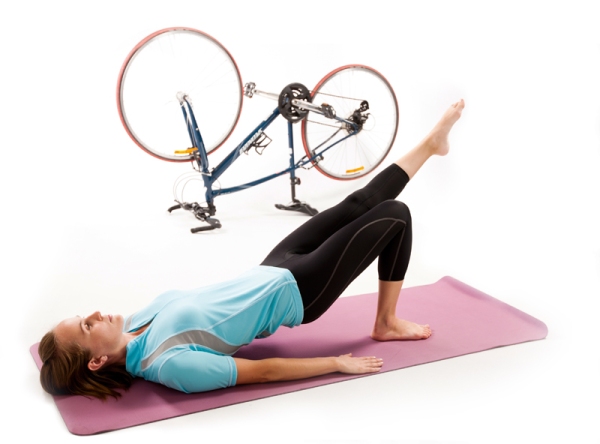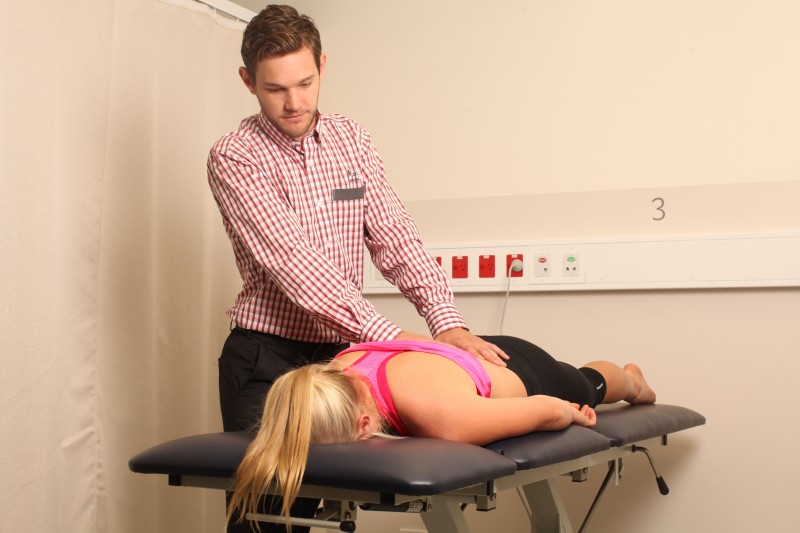Pilates for bike riders
You’ll find poise and balance on the bike and in life with Pilates finds Debra Mayrhofer.
One of the most vital skills for riding with others is the ability to hold your line while you are doing other tasks, such as reaching for a drink bottle, signalling, scanning behind or even just ringing your bell.
Beginners and experienced riders alike struggle not to veer when doing these things, despite their best efforts. The problem often lies in their core strength and flexibility, rather than their experience on the bike. The good news is that one of the easiest ways to solve this problem is by incorporating Pilates into your life.
Pilates has evolved from a movement method developed in the 1920s by Joseph Pilates and originally called Contrology. Although there are now a variety of styles of Pilates – some using complex equipment and some just a simple mat – the basic principles remain the same.
The aim of Pilates is to balance the body and promote functional movement by optimising strength, flexibility and mobility.
Pilates exercises are performed with the core muscles engaged, and this concept can cause some confusion. The core muscles are the deep muscles which support your trunk and can’t be activated by simply sucking your tummy in. So forget the flashy sixpacks which are formed by the superficial rectus abdominis muscles. You want to work the deeper muscles of the pelvic floor and the transversus abdominis. To do this, visualize the muscles that form a sling between the pubic bone and your two sitting bones and then imagine that sling tightening upwards and towards the centre line of your body. If that doesn’t work for you, imagine you are trying not to urinate or pass wind. Now keep breathing, keep engaging the pelvic floor and add the final element by contracting your transverse abdominal muscles, between the pubic bone and the navel, inwards. It takes a bit of concentration at first, but trust me, it does get easier and can be done while cycling.
A regular rider herself, Karin has developed a program of cycling specific Pilates routines for both recreational and competitive cyclists.
While there are some similarities with disciplines such as yoga, there are core differences (no pun intended) in the way the body is used. For example, in yoga it is common to do a standing forward bend with a straight back, whereas in Pilates the aim is to roll the upper body down towards the toes one vertebra at a time. The static nature of yoga poses and the breathing techniques also differ. Perhaps the most obvious difference though, is that in yoga the integration of mind and body, and the focus on the spiritual or meditative aspects, are more emphasised, whereas in Pilates exercises are directed towards developing efficient movement habits that translate into daily life.
“The goal of Pilates is a balanced body, in harmony with gravity,” said Pilates instructor Karin Sharp-Gurtner, one of the directors of the Sense of Space Pilates Studio in Subiaco, Western Australia.
“Hence the focus is on the body’s core, toning the deep abdominal and back muscles that stabilise the pelvis and the spine. Pilates literally works from the inside out, improving freedom of movement from head to toe.”
A regular rider herself, Karin has developed a program of cycling specific Pilates routines for both recreational and competitive cyclists.
“One of the key elements in Pilates is elongation and stability of the spine, as well as proper pelvic alignment. This allows for powerful and streamlined extremity movement, in this case pedalling action. The push and pull of the legs becomes more energy efficient and ergonomic, hence power and endurance improve,” said Karin.
Although our leg muscles are well developed, cyclists tend to have shortfalls in other areas.
“Our neck muscles often get tight from looking forward while we are hinging at the hips and lower back,” said Karin. “After a while the shoulder and back muscles might start to hold extra tension due to the position they are in.
“Many cyclists develop short hip flexors and an imbalance in their hip extensor muscles, which can then put stress on the lower back and the knees.
“Pilates can address all of this with specific flexibility and strengthening exercises.”
Karin said that she mixes steady movements matching the consistency of bike riding with complementary oscillating movements and she generally includes standing and weight bearing exercises into the routine.
While the benefit of greater power and endurance is obvious for competitive cyclists, it can also make a long day of cycle touring more comfortable.
For time trial riders, the increased flexibility in the back allows for a more streamlined riding position and reduced drag, cutting crucial seconds from your time.
For those of us who just want to hold a steady line in traffic, the ability to remain centred and allow the upper body to turn or move without throwing the whole position out of alignment is vital.
As a simple experiment, next time you need to reach for your bottle or look over your shoulder, consciously engage your core muscles first. You’ll be surprised at the improvement in stability.
While it’s best to attend classes to get guidance, you will find that once you are familiar with Pilates you can incorporate exercises into all aspects of your daily life, whether it’s waiting at traffic lights, standing at the photocopier or on the bike itself. Once you’re on the path with Pilates you will look back – but this time you won’t wobble.
Diagonal limb stretches
The key here is to move the limbs straight away from the body keeping the core engaged and the back flat.
 1. Kneel on all fours, with limbs at 90 degrees to your torso, and the neck relaxed so you are looking at the floor just in front of you.
1. Kneel on all fours, with limbs at 90 degrees to your torso, and the neck relaxed so you are looking at the floor just in front of you.
2. Keeping the body still, engage the core muscles and independently straighten each arm and leg in turn.
3. Once you have worked each limb on its own, straighten diagonally opposite arm and leg pairs together: right arm and left leg, then left arm and right leg. Again, focus on keeping the core engaged and the rest of the body still.
Common mistake: arching the back and swinging the legs or arms above the plane of the body into a lift; or lifting the head to look forwards so it isn’t in line with the spine. Remember that you don’t want all your weight following your hand when you reach down for a water bottle, so this movement is critical.
Standing twist
The key here is to keep the hips still and facing forwards no matter what the upper body does.
 1. Stand with the knees relaxed, hands on hips.
1. Stand with the knees relaxed, hands on hips.
2. Keeping the hips still, engage the core muscles and twist from the waist. Only go as far as you can without compromising your hip position.
3. Repeat the movement, starting with the arms at shoulder level straight out in front. Keeping one arm still, draw back the other in an archer movement, then straighten it behind you, drop the arm to your side and return to the starting position. Repeat with the other arm.
Common mistake: allowing the hips to follow the movement of the upper body. Remember the bike will go in the direction your hips are facing, so mastering this is key to stability.
Find a Pilates studio Pilatessource.com.au
Debra Mayrhofer is an accredited Trainer and Assessor with AustCycle and Road and Track coach with Cycling Australia.
Ride On content is editorially independent, but is supported financially by members of Bicycle Network. If you enjoy our articles and want to support the future publication of high-quality content, please consider helping out by becoming a member.









3 thoughts on “Pilates for bike riders”